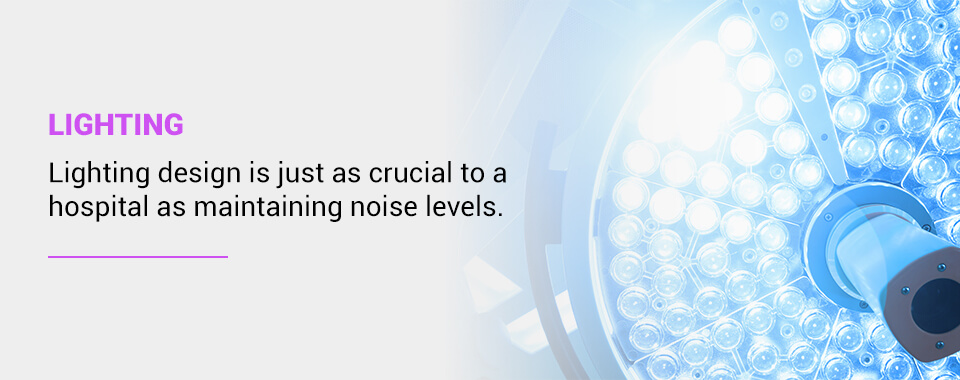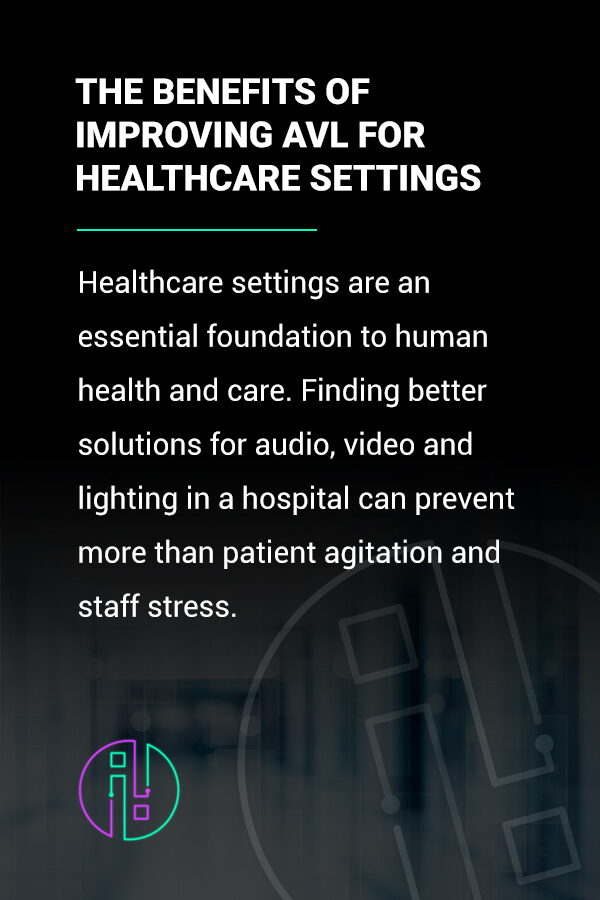

AVL, or audio, video and lighting design, is critical for any facility. Healthcare and medical buildings, such as hospitals, can significantly benefit from proper AVL design. Staff workers may see fewer mistakes when dispensing medications with improved lighting and sound, and patients may feel less depressed or agitated by loud noises. With enhanced visuals, hospitals can post adequate signage throughout the hospital to guide visitors in the right direction.
Visual and auditory privacy is also another essential aspect that can be improved in many healthcare settings. However, reducing medical errors in a hospital is one of the most vital ways that AVL design can help improve healthcare processes.
Our senses are in tune with everything around us. In healthcare settings, high-stress procedures and emotional visits between loved ones heighten senses. There are many ways that custom sound, lighting and visuals can affect those in a hospital, doctor’s office or similar healthcare facilities.
Different noise levels encompass several elements of hospital sound. According to the World Health Organization, noise levels should not exceed 40 dB. For reference, anything above 85dB is considered dangerous for human ears, and most conversation is held around 60dB. The most common sounds that affect visitors, patients and healthcare staff include:
Speech privacy refers to noise levels that can be heard from different rooms or areas in a healthcare building. This could include situations when a doctor is trying to have a confidential conversation about test results or a diagnosis with a patient and their family. Speech intelligibility, however, refers to the ability to clearly hear and understand communication from another person in a hospital without being affected by noise levels or echoes. These aspects of sounds are different depending on the time of day and business of the establishment.
However, distracting, loud noises can negatively impact patient comfort and staff communication. The environmental design of a hospital or healthcare facility can contribute to noise levels. Hospitals tend to have surfaces that reflect sound, causing lingering echoes and reverberation. This can increase the overall noise level in the facility, distracting workers and preventing patients from getting restful sleep.
Pleasant sounds, like music, on the other hand, can often have relaxing and stress-reducing effects. Sedative music acts as a therapeutic means of calming patients preparing or healing from intense procedures. However, excessive noise during the night can even raise a patient’s blood pressure and heart rate, potentially slowing their healing process. High levels of noise or unnecessary sound can also affect hospital errors, which can have detrimental impacts.
For example, nurses, doctors or other clinician staff may have difficulty hearing and conversing about medications, leading to incorrect dosage or drug dispense. Noise pollution in hospitals can also determine sound in operating rooms. This noise exposure that negatively impacts doctors often comes from communication devices, medical machines, crowds and outside noise or vehicles. Overall, many aspects can affect hospital acoustics and lead to more irritable, anxious or frustrated staff and patients.

Lighting design is just as crucial to a hospital as maintaining noise levels. Proper lighting in hospitals and healthcare settings may positively impact many aspects for patients and medical staff. A hospital without intentional lighting design can even affect the level of medical care. Inadequate lighting can lead to many other issues in healthcare environments, including:
These are just a few reasons why the right lighting is so essential. Adequate illumination is necessary because it can help prevent fatigue, which is critical for healthcare staff working night shifts. Performance, productivity and mood also improve with proper lighting, as patient care and decision-making are often more difficult without it. One survey stated that 87% of nurses believe lighting contributes to task accomplishment when dealing with medications.
As you can imagine, lighting is equally important in areas of operation, where medical and surgical procedures take place. Surgeons dealing with lighting difficulties during a procedure can cause additional stress or errors. Proper lighting design in these areas is especially critical to avoid any issues with tangling, adjusting, collisions or other ergonomic lighting problems.
Avoiding errors, burnout and feelings of exhaustion for staff and patients can also be accomplished with plenty of windows for natural light during the day. Natural light should be implemented in the hospital’s design as much as possible, and bright lights can be installed in all areas to maintain illumination at night.
Visual elements in a hospital can also affect workers, patients and visitors in a hospital. Visual aspects can include design, signage, videos, layout, privacy or other factors that contribute to patient safety and comfort. The visual layout or overall design of a hospital can impact feelings of stress, depression or restlessness, but it can also impact patient health. The architecture of a hospital can change health outcomes, as it may lead to, or prevent, the spread of infectious diseases.
However, this depends on a few factors, including patient and staff flow and cross-ventilation. Other visual information, such as color and lighting, can alter a patient’s impression of their environment. A less-than-favorable layout may lead to psychological stress amongst staff members and patients, potentially increasing medication dispensing errors and slow recovery processes.
Digital signs also fall under the visual category. These signs can be implemented throughout the hospital or healthcare facility to provide direction for patients, visitors and new staff members. Proper AVL design in healthcare considers these visual aspects to create an environment that is easy to navigate. Visual signs are also helpful for posting educational reminders and notes for staff or enhancing medical conference rooms, meetings and presentations. Improved videos and lighting and audio can also upgrade MRI procedures and other medical testing.
Another essential aspect to consider in visual design is privacy. Privacy is essential in hospitals for many reasons. Patients deserve visual privacy when changing into operating gowns, using the bathroom or sleeping. Family members and loved ones also deserve privacy when visiting a patient or speaking with a doctor or nurse about sensitive information. Visual privacy often goes hand in hand with speech privacy, allowing workers, patients and visitors to converse, work and rest without excessive disturbance.

Healthcare settings are an essential foundation to human health and care. Finding better solutions for audio, video and lighting in a hospital can prevent more than patient agitation and staff stress. The most common benefits of improving AVL are in hospitals and healthcare facilities.
Poor lighting can lead to patient or visitor falls, resulting in lawsuits or other litigation costs. The medical liability system brings in billions of dollars every year. Though these liabilities encompass a broad area of errors, patient care and safety are highly connected with AVL in healthcare systems. Proper lighting and signage can help reduce the chance of a patient falling in a poorly lit hallway or healthcare staff bringing medication to the wrong room.
Companies like Illuminated Integrations can construct AVL design solutions that may reduce accidental injuries or errors. There may also be diminished liability among patients and workers with suitable lighting, signage and audio. Due to dim lighting, low speakers or communication devices, lack of signage and improper architectural flow, staff errors will only create more expenses.
Making the right decision to incorporate sufficient AVL design in a healthcare facility or hospital can help reduce costs as risk management practices improve patient care. Appropriate AVL solutions may also help reduce energy consumption, decreasing overall costs.
Patient room lighting, and lighting throughout the facility, should be designed to improve sleep while allowing healthcare workers to perform their jobs at any time of day. Improving and increasing sleep times with adequate lighting can lead to better patient health outcomes. Improved audio and video can also assist workers in providing higher-quality testing and procedures for patients. A well-designed hospital that incorporates signage and flow to improve privacy and communication can also make patients feel more at ease, leading to faster recovery.

Sleep deficiency can be detrimental to human health, especially for those recovering from injuries, illness or surgery in a hospital. Patients may have trouble sleeping if they can hear every slight noise or conversation around them in the hospital. AVL design can help combat this as noise levels are reduced to offer better chances of restfulness. Natural light or bright lights adjusted to the right colors can also have a psychological impact on patients, reducing their stress and helping them feel less anxious.
Relaxing music played through speakers can also help to calm patients and visitors, keeping noise levels down. With sufficient lighting and audio, surgeons, doctors and other medical staff will have an easier time performing medical tasks or dispensing medication. This improvement may reduce medical errors and long wait times for patients and visitors.
Improved AVL can relieve hospital staff by reducing noise in the facility. With less tension and anxiety, they may also perform their jobs more effectively, leading to fewer mistakes and frustrations. Workers highly value aspects of their workplace environment, with 58% concerned with air quality, 50% comfortable light, and 30% comfortable acoustics. This survey also found two-thirds of respondents said their workplace affects their health and wellbeing.
This means the overall improvement of the facility can help make workers happier. Happier employees may lead to increased morale in a hospital or healthcare setting. This high satisfaction among staff will undoubtedly influence the way visitors and patients feel about the facility.
Improving the quality of patient care is a goal for any healthcare facility. When workers have sufficient lighting, audio and video to better perform their jobs, the quality of patient care is likely to improve. Some patients who rely on light exposure, such as NICU infants, require the appropriate luminance for their health and progress. This lighting should be measured and installed correctly to avoid shining direct light in an infant or other patient’s eyes when monitoring or performing a task.
With the right solutions, such as those installed by Illuminated Integrations, this essential lighting can be made easily adjustable, ensuring quality care standards. Patient care can also be improved when communication among staff is enhanced with better hospital flow, signage and audio. Communication devices can help with this and improve speech intelligibility with proper architectural design.
While color and lighting are important for countless reasons in a hospital, audio is just as essential. Proper audio in hospital speakers or communication devices is vital for emergency alerts or nurse codes. Suppose there is an issue with a patient and a doctor or specific staff member needs to be contacted quickly. In this case, a poor audio speaker or InterCall system that is muffled or breaks up sound with static can prevent audible communication in the hospital.
Overhead speaker systems may even be replaced with hands-free devices or smartphones to reduce noise or chances of misinterpretation. Nurse call systems and other healthcare audio rely on AVL solutions for the appropriate placement, capabilities, maintenance and sound to avoid accidental issues with hearing and seeing signals for care. Patients who request assistance can also benefit from improved AVL in this aspect.
Patients may have an easier time notifying nurses and other medical staff with light systems or enhanced audio alerts. The audio in a medical procedure or testing rooms may also be improved, leading to more peace of mind for workers and patients.
Another benefit of improving AVL in healthcare is caring for patient privacy and comfort. Privacy is essential for patients to feel comfortable sleeping and eating, which is critical to the recovery process. Updated AVL solutions can reduce speech intelligibility in areas where it’s needed while enhancing speech privacy. This can help patients feel more comfortable while they recover in a hospital for days or weeks at a time.
Transfer sounds won’t be as likely to disturb sleeping patients, and noise from the reception desk or cafeteria will also be diminished. Doctors, nurses and other medical staff will also be happy knowing others are not overhearing their confidential or private discussions with patients and family. Along with audio privacy, visual and physical privacy can also be enhanced with the flow and design of the hospital. Visitors may feel more relaxed in waiting areas, and workers may feel calmer while performing tasks with reduced noise and visual traffic.
When hospital workers deal with fewer mistakes and frustrations, their happiness and quality of patient care can increase. It has been proven that happier workers are more productive, which is essential in a healthcare setting. Hospital workers won’t have to constantly double-check medication names or dosages when communication is improved with AVL design. They also won’t need to stop their work to find someone to fix or find supplemental lighting for an area where it is needed.
All of these obstacles and hindrances can slow down productivity and irritate those trying to perform an important task. Increasing productivity and communication among workers, patients and visitors can also help reduce confusion when navigating the hospital or during procedures. Improving safety and efficiency will help lead to more effective practices. Ensuring the audio, video and lighting in a hospital is high-quality and meets the adjustable needs of healthcare workers can lead to better outcomes for all.

The benefits of improving AVL are clear. In your healthcare facility, you can increase the level of satisfaction and reduce stress by implementing proper AVL design with Illuminated Integration. We are an AVL company dedicated to producing unique, seamless designs for projects of any size or complexity. We know how important it is to install the right lighting fixtures and other elements to make hospitals safer and more efficient.
At Illuminated Integration, we serve a wider range of industries in need of AVL solutions. Our team of professionals is committed to providing creative options and developing a positive user experience. We want to make an immersive, integrated atmosphere for your workers, patients and visitors. Contact us today to tell us about your project and see how we can help you achieve your healthcare design goals.